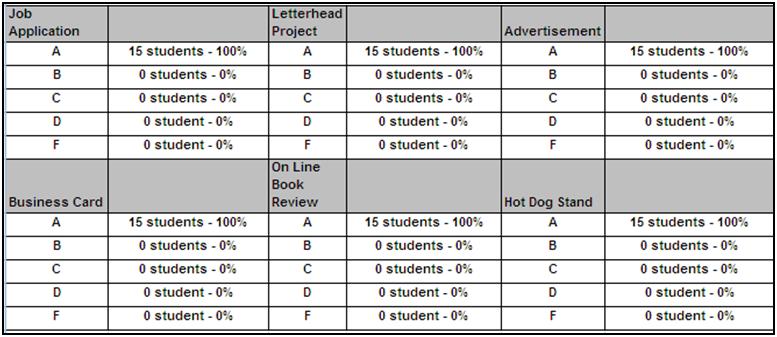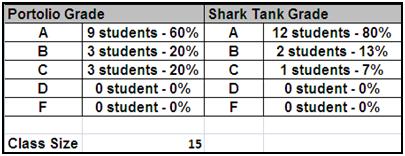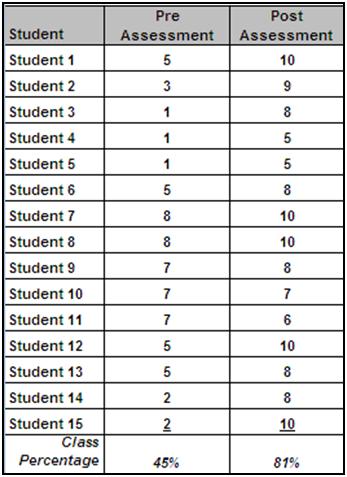|
It’s ALL
Business: My Life in the Corporate World
A Middle School Keyboarding Unit
I.
Introduction/Overview
Middle school keyboarding is a 6th grade Career and Technology
Education (CTE) course. It is the students’ first business
class. It is an 18 week semester course with goals focusing on
student improvement in technique, accuracy, and speed. In my
class, I focus heavily on projects which encompass a wide variety of
authentic problems (e.g. small business owner, advertisement writer,
magazine designer, graphics designer) for students to complete. I
offer a total of 12 projects during the course (e.g. business cards,
resume, advertisements, business letters, and career research).
Macro demographic highlights of the school and county include:
Farmwell Station Middle school is a Loudoun County Public School of
roughly 1300 students, including 478 6th graders. The demographic
data is presented in the following charts.
For 2012, additional Farmwell student profiles can be found here.
|
Did
Not Complete High School
|
4.81%
|
|
|
|
Completed
High School
|
16.03%
|
|
|
|
Some
College
|
18.71%
|
|
|
|
Completed
Associate Degree
|
7.47%
|
|
|
|
Completed
Bachelors Degree
|
35.73%
|
|
|
|
Completed
Graduate Degree
|
17.25%
|
|
|
Parental educational levels are diverse
and wide ranging. From
census bureau summary, Farmwell parents have a broad range of
backgrounds with a predominance (over 59%) having a Bachelors or
Graduate degree. The national average is 10% lower for these
degrees. Additional census information can be found here.
Other data areas of note about the population of Loudoun County, as a
whole, include: 1) It is the fastest growing county in the
country over the past 10 years; 2) It has consistently been
one of the most affluent counties in the United States, earning the
“richest county in the United States” several years running
with an average household income of $119,000 (2012); 3) the Median
price for homes is $525K, one of the highest in Virginia and in the top
10 for the country.
II. Unit Goals
From a broad perspective, this quarter unit will further
students’ keyboarding basic skills (technique, accuracy,
speed). However, now this quarter will be dubbed
“It’s ALL Business” and students will be immersed in
the business realm and gain real world experience of what it might be
like to have a job in business and be promoted. They will not
just thinking about how it is done, they will do it. This unit
will be a nine week corporate “simulation experience” for
students. The unit will strongly link “living with learning
and learning with living” as well as linking several school
disciplines (Art, Math, Keyboarding, and Language Arts) to corporate
world of employment. In addition to the traditional grading
criteria for keyboarding, students will now get additional incentives,
including pay, a bonus structure, and a promotion. For a
full unit plan description, click here.
From an instructional perspective, there are both covert and overt
components to the unit that I hope to cover. The overt goals
include students experiencing daily goals/objectives and structures
that mimic the business world. They will be assign tasks,
projects, and work to be completed during the class block; 2) research
skills; 3) direction following—written AND oral; 4) DEAPR,
C-RAP, SSCC, ACTS, PICKL—depending on the project and
timeframe of the unit. My covert goals include: Through the use
of the seven projects and lemonade stand (business simulation video
game), students will have time to reinforce and use their search, sort,
create and report skills in great depth. There will be many
opportunities to implement the design, encode, assemble, publish
(Business Card, Business Letter, e-Magazine Article) and review process
(Business Plan, Portfolios) to increase their knowledge of the concepts
outlined above.
Overall, I want students to learn these covert and overt
objectives. From a covert standpoint, the concepts of SSCC,
DEAPR, C-RAP, authentic problems, software usage, analysis, critical
thinking, and project completion will be covered. Student
outcomes include using these to produce the 7 projects and be promoted
through the 6 promotional levels during a 9 week unit. This will
culminate in a final presentation in a “Shark Tank” format
where they will present their portfolios and business plans to a group
of industry experts. I want them to learn
what it is like to have a “real world” experience in the
classroom. Students will learn several valuable skills including
organization, focus, deadlines, good work ethic, time management, and
goal setting. All of these simulate the corporate world.
Additionally, students will have goals, tasks, promotions, and
bonuses. Listening and following directions, organization,
discipline, focus, design concepts, create, sort, arrange, software
packages, and image manipulation will be important learning
goals. These will be reinforced through the following Promotion
and Deliverable schedule:
Promotion Schedule
Promotion
Levels—6 total
(Throughout the unit, students to keep excel game log with sign off by
instructor)
1 ) Sales Representative (Job research
and application); 2) Account Manager (4 MicroType Lessons, 1 week of
Play, 40% or higher customer satisfaction rate, profitable); 3) Manager
(4 MicroType Lessons, 1 week of Play, 50% or higher customer
satisfaction rate, profitable); 4) Director (4 MicroType Lessons,
1 week of Play, 60% or higher customer satisfaction rate, profitable);
5) Vice President (4 MicroType Lessons, 1 week of Play, 70% or higher
customer satisfaction rate, profitable); 6) President (4 MicroType
Lessons, 1 week of Play, 80% or higher customer satisfaction rate,
profitable).
Deliverables
Schedule
Projects—7 total
(Students are to keep these in an
electronic portfolio/folder)
1) Job Application; 2) Business Card; 3)
Letterhead/Business Letter; 4) eMagazine Article; 5) Advertisement; 6)
Hot Dog Stand; 7) Wiki based High level Business Plan presentation.
Due to the duration and depth of this unit plan, motivational goals are
far reaching. These include students participating in a
collaborative environment. They and the instructor will work
together to solve any issues (projects, progress, behavior) that come
up during the quarter. Overall, it is imperative for students to
strive to do their best on all projects and be sure work is complete
and matches the rubrics. Through elements in the unit (authentic
problems, projects, roles, advancement, bonuses), my overall
motivational goal for students is to encourage life-long learning. I
hope students will associate what where viewed as discrete, stand alone
subjects (LA, Math, Art/Design, Keyboarding concepts) that they have in
school as unified and wrap them up into what it might be like to be in
a corporate job environment. That learning is never ending and a
constant application of concepts will ensure their 21st century
success.
The evaluation strategy on this unit will include elements from student
and instructor based feedback. Student assessment on this unit
will be detailed and measure multiple factors. From a broad stand
point, I need to measure two things: 1) What they learned and 2) how
they liked it. I have incorporated several aspects of student
assessments from previous lesson plans and expanded them to cover a 9
week unit. From an instructor perspective, a teacher journal will
be kept along with reflective notes on what worked and what did not.
Improvements and modifications will be made to improve the delivery of
the content. There will also be a notes section for the Shark
Tank (industry professionals) to provide comments and insights.
System
of Assessments
(Note:
links for sample rubrics in the student sample section)
1) Project Rubric(s)—Each
will have its own requirements; 2) Portfolio(s)—all final
deliverable project work; 3) Survey(s)--Exit Survey (3
questions): What did you like? What did you learn? How
would you improve?; 4) GWAM (Gross Words A Minute)--Speed scale
used to assess speed of student typing; 5) Game Log--Records
scores/profits/customer satisfaction rates; 6) Pre/Post Assessment: 5 questions
on importance of job application, business card importance/function,
business math, plus other background material in an online survey.
III.
Quantitative Evidence of Student Learning
The quantitative data was collected through the use of the grading
rubrics for all students in my class. Below are summaries of the
quantitative data collected through the use of the grading rubric for
all students.
For the promotional projects, I directly expressed to students that
meeting expectations for the rubrics on projects would result in an A
provided the requirements were met. If not, students would rework
the projects until correct. For the culminating activity,
students were placed in teams of at 5 for a total of three teams but
were still graded individually.
Initial analysis of the data shows that students did well. All
students met the expectation for the promotion projects. For the
Shark Tank project, the class averaged 89%, again very high and a great
indicator of learning but still inconclusive. The Pre/Post
Assessment numbers provide the strongest suggestion that learning took
place. Student took an ungraded, online, 10 point pre-assessment
that had 5 main concepts on the unit. At the end, students then
repeated the assessment. The class average was significantly
higher when comparing pre and post test percentages.
Promotion Projects

Culminating Activity
Pre/Post Assessment
IV.
Qualitative Evidence of Student Learning
Qualitative learning evidence was noted by three areas: teacher
notebook, Shark Tank Comments, and the “Exit
Interview.”
First, from a teacher journal/notebook standpoint, I was constantly
jotting
notes. Comments included: Student behavior (felt challenged but
fun, excitement, nervous but prepared for the Shark Tank). Deal
with students in a fair manor, they feel respected. If they feel
respected, they feel like part of the process; if they feel like part
of the process, their interest level grows. So goes the projects.
Second, the concept of the Shark Tank really helped team members with
their presentations. The comments and feedback were very
insightful and did shed light on evidence of student learning.
Shark Comments and Criticisms (verbal and from rubric):
General comments: “Extremely
creative…nice presentation. Format on this was good.
Perhaps, they could have used more time to present. Constructive
criticism: “They needed more time. Overall, this is about
as real world as it gets. I am impressed. They learned a
lot.”
-Tony Arko
General
Comments: “Impressed with the iPhone app idea. I
would download it!!! Cannot believe this came from 6th grade
keyboarding!” Constructive criticism: “Very
minor. You may be trying to do too much or more time. The
portfolios were great but some seemed sparse. It is 6th grade but
they are way ahead of other kids.”
-Christen Badgley
General
Comments: “Great job would use more time and get more
detail into the presentation. Constructive criticism:
“None. Great ideas and the kids seemed
engaged.” You sure you don’t want to get back into
being a VP of Sales? I would love to hire you back! You
have them on point!”
--Brian Mahoney
In wrapping up the Shark Tank thoughts on
learning, reviewers noted several times how great it was to tie in real
world problems to the classroom in each of the projects and how mature
the various projects were—“not the typical 6th grade type
stuff, but pretty good.” Their comments were excellent and
valued. Learning all these things about business in 6th grade
will put them way ahead in the future and help them to see the
relevance of their other classes (math, art, and language arts, in
particular). “The Sharks” were the perfect reviewers:
prepared, yet good natured, serious but with a sense of humor.
Just like the show and just like the business world, they were dynamic
and changing. Bringing in the business world people on this was
great for students and teacher. Thanks Dr. Norton for the nudge
to “bring in other people from the community.”
Lastly, students’ “Exit Interview” had some very
interesting comments. Student learning was clearly present here
as well. I have highlighted comments from their business plan
wiki and verbal comments that were shared during the exit interview
component of their presentation:
Question 1: What did you
learn?
o
“Being in a company is stressful. Having goals
helps.“
o
“Starting a company is not as hard as I thought.
Brainstorming with others on ideas was neat.“
o
“The Shark Tank presentation was hard but they were cool.”
o
“Biggest thing I learned was managing my time. That is hard
but I finished.”
o
“I want to be the President of my own company someday.”
Question 2: What did you
like about this lesson?
o
“It takes a lot of work to get promoted—and a grade.”
o
“Business and promotion are a lot of fun. I hope being in a
real job is this much fun.”
o
“The projects were real things that business people do. It
seemed real.”
o
“I liked the projects and searching.”
o
“I liked keyboarding more last quarter. This was too hard
and complicated.”
Question
3: What changes would you make?
o
“None…it was cool.“
o
“At times it was difficult but one you get into it, it was
fun. Maybe easier projects/less reading. “
o
“The wiki was too short…”
o
“We did a lot--maybe too much. Less projects. The
math part was math….”
o
“I would change the teams—too many people. Let us
pick them.”
Again, taken together, these comments
clearly show keen insights into the learning process and
students’ true feelings about the Unit. For the most part,
they were eager to learn, ready to have fun, and immersed themselves
into the experience.
V. Samples of
Student Work
I have included samples that illustrate
the broad range of student capabilities. Some are very detailed
and realistic, while others are more sparse. Yet, they still
followed the requirements in the rubric. The wiki is a link to
the entire site
so you can get a view of how the wiki business plans were
developed. Username: wikiuser0003; Password: bird8fig.
VI. What Worked
This unit had the potential to be burdensome and overwhelming for both
students and teacher, I am happy to note that it rocked. First,
the Teacher Journal is yielding a great source of information in a
real-time, note taking class environment. This helps to capture
thoughts and comments quickly. Second, the students’
“exit interview” reconfirmed that I need to think about my
students learning likes, dislikes, and areas for improvement.
These will help the next time I teach the unit. Third, the Shark Tank people were phenomenal and played
their roles well. Some were very hard and probing on some
students and easy, at times, on others. They really added value
to the experience, and they were viewed as experts in their
roles. Some students mentioned that they were intimidated.
That said, I believed they worked harder knowing that the experts would
be critiquing their portfolios. Fourth, the Pre/Post assessments to
check for understanding were valuable. They did show that the
students learned from this experience. Last, the “Model, Coach,
and Fade” technique works extremely well in taking out confusion
and initial level questions for this unit. It was a huge unit,
and this really helped the verbal and visual learners glean insight to
the project requirements at a higher rate. This held true for the
special needs students as. They picked up on what was needed and
performed at a high level.
VII. What
Would You Change or Modify
To be perfectly honest, there are very few things I would change.
The pacing was good, and student enjoyment high. I would allow
more time although many of my time constraints were due to the ITSer
timeframe for work completion.
VIII. Lessons
for Your Practice
In terms of lessons for my practice, there are three main take
aways: The authentic problem, the value of the exit interview,
and the teaching model of “Model/Coach/Fade.”
The authentic problem is a huge positive. Students linked to the
real world and communities and felt that it was realistic.
They were highly motivated and performed well. Their quality of
work was exceptional, and their presentation delivery was high.
There were minimal classroom disruptions, and the collaborative nature
was high. Student engagement was extremely high.
By incorporating the exit interview, students provided comments to
improve the process for other students. This lends credence to
the assumption that students feel good when they are involved in the
process. It is truly participatory. They have greater
control and can be more emotionally invested in the process, projects,
and deliverables. As such, the process improvement in my practice
continues as an endless cycle. If students can provide meaningful
feedback to their academic activities, my plans and experiences will
benefit the next time I deliver the unit. It is a two way street
if you will. I heard several times during the interview comments
that I thought were very indicative of student engagement and learning.
The teaching model of “Model, Coach, and Fade” will become
my standard for introducing all units and projects. It is a
powerful tool for my designer’s tool bag. Using this
process ensured the success of this unit especially since the unit was
so broad and the deliverables so varied. It is just the best
approach and fits my teaching style very well. It produces a
better learning experience with far fewer questions and classroom
confusion. Several of the students commented on this as
well. They appreciated it when they could see me do an example
first by working through the process helped them be more confident and
successful during the unit.
|




